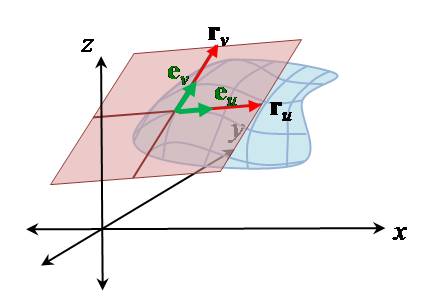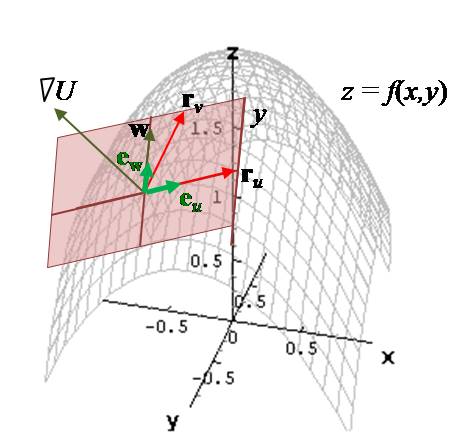Tangents and Normals to Graphs of Functions
If f( x,y) is differentiable at ( p,q) ,
then linearization of f( x,y) at ( p,q) leads to
a tangent plane to z = f( x,y) at ( p,q,f( p,q)) of
|
z = f( p,q) +fx( p,q) ( x-p) +fy(p,q) ( y-q) |
|
This formula was developed using the total derivative.
However, we can also
find the tangent plane to z = f( x,y) at ( p,q,f(p,q) ) by
(a)
considering the level surface z-f(x,y) = 0 or
(b) considering the parameterization
r( u,v) =
á u,v,f( u,v)
ñ at the point r( p,q) .
The result is the same for
all 3 methods.
EXAMPLE 5 Find the equation of the tangent plane to f(x,y) = x2 - y2 at ( 1,2) by (a) linearization of f( x,y) at (1,2) (b) considering the surface
z- f( x,y) = 0 at ( 1, 2, f(1,2) ) and (c)
finding the tangent plane to a parameterization of the form
|
r( u,v) =
á u, v, f(u,v)
ñ |
|
at r( 1,2) . The answer should be the same in all 3
cases.
Solution: (a) Since fx = 2x and fy = -2y, we have fx( 1,2) = 2, and fy( 1,2) = -4. Thus, f(1,2) = -3 and correspondingly, the equation of the tangent plane is
|
|
|
|
f( p,q) +fx( p,q) ( x-p)+fy( p,q) ( y-q) |
| |
|
|
|
which simplifies to z = 2x-4y+3. (b) If U( x,y,z) = z - (x2-y2) , then
Since f(1, 2) = -3, the point of tangency is (1, 2, -3) and
|
ÑU( 1,2,-3 ) =
á -2,4,1
ñ |
|
Using ÑU( 1,2-3) as the normal, we obtain
|
-2( x - 1) + 4( y - 2) + 1( z - 3) = 0 |
|
which upon solving for z yields z = 2x - 4y + 3. (c) If we let
|
r( u,v) =
á u, v, u2 - v2
ñ |
|
then ru =
á 1,0,2u
ñ and rv =
á 0,1,-2v
ñ . Thus,
|
ru( 1,2) =
á 1, 0, 2
ñ and rv( 1,2) =
á 0, 1, -4
ñ |
|
and ru( 1,2) × rv( 1,2) =
á -2,4,1
ñ , which is the same as ÑU(1,2,-3) . Since r( 1,2) =
á1, 2, -3
ñ , the equation of the tangent plane is again
Of course, in applications only one approach is necessary. But there
are applications when one method is preferred over another. For example, there
are applications when it is necessary to have an orthonormal basis for the
tangent plane -- i.e., two unit vectors
eu and ev in the plane that are perpendicular to
each other. For an orthogonal parameterization r(u,v),
we need only rescale ru and rv into unit vectors
eu and ev, respectively, to obtain the desired orthonormal basis (such rescaling is known as normalization).

However, if
r( u,v) =
á u, v, f(u,v)
ñ, then ru . rv = fufv
, which is typically non-zero. However, if we let
U(x, y,
z) = z - f(x,y) where x = u, y = v, then the
vector
is in the tangent plane and is perpendicular to ru
. Normalizing ru and w
results in an orthonormal basis for the plane.

Conversely, proofs of theorems often begin with an assumption that a
parametric or level surface implicitly defines z as a function z = f(x,y) in a coordinate patch of
the surface containing a given point, thus allowing techniques and ideas as in
chapter 2 (or we may assume that x is implicitly defined as a function
of y, z, etcetera).
Check Your Reading: What is
ÑU(1, 2, -3) if we let U(x, y,
z) =
f(x,y)- z in example 5?


